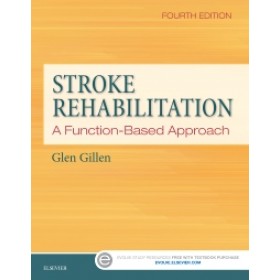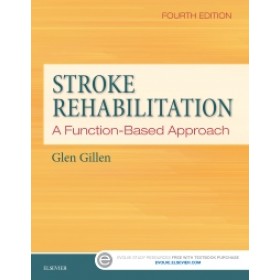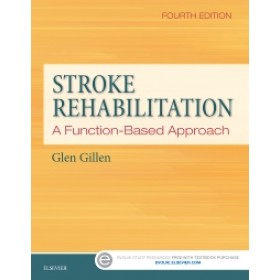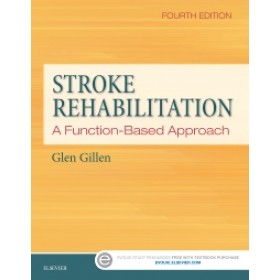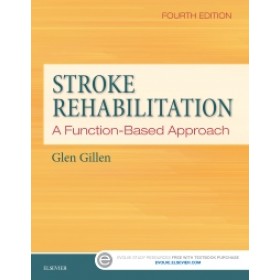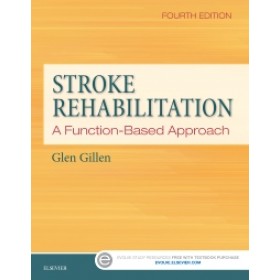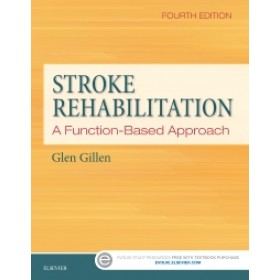Details
Share A Course: Stroke Rehabilitation, 4th Edition: A Function-Based Approach: Module 4
SKU: 784S
Do you already have access to the reading materials and only need the testing materials? Are you planning to Share A Course with someone else who already has the reading materials?
These courses are offered in cooperation with Elsevier Health and utilize the hardback textbook, “Stroke Rehabilitation: A Function-Based Approach, 4th Edition” by Glen Gillen, EdD, OTR, FAOTA.
Learn to confidently manage the growing number of stroke rehabilitation clients with these exciting new courses! Using a holistic and multidisciplinary approach, this text remains the only comprehensive, evidence-based stroke rehabilitation resource for occupational therapists. The new edition has been extensively updated with the latest research in assessment and intervention, along with more evidence-based research added to every chapter. As with previous editions, this comprehensive reference uses an application-based method that integrates background medical information, samples of functionally based evaluations, and current treatment techniques and intervention strategies.
Module 1: covers pathophysiology, medical management and acute rehabilitation of stroke survivors, psychological aspects of stroke rehabilitation and improving participation and quality of live through occupation.
Module 2: covers the task-orientated approach, activity-based interventions in stroke rehabilitation and approaches to motor control dysfunction.
Module 3: covers trunk control, balance impairments and vestibular rehabilitation when performing stroke rehabilitation.
Module 4: covers upper extremity function and management and rehabilitation technologies to promote upper limb recovery after a stroke.
Module 5: covers edema control, splinting applications and functional mobility after a stroke.
Module 6: covers gait awareness, managing visual and visuospatial impairments to optimize function in patient who have had strokes and the impact of neurobehavioral deficits on activities of daily living.
Module 7: covers enhancing the performance of activities of daily living after a stroke, the treatment of cognitive-perceptual deficits using a function-based approach and managing speech and language deficits after a stroke.
Module 8: covers driving and community mobility as an instrumental activity of daily living, parenting after stroke, dysphagia management and sexual function and intimacy after a stroke.
Module 9 covers adaptations for activities of daily living, leisure activity participation after stroke, seating and wheeled mobility prescription and home evaluation and modifications for stroke patients.
Course Length: 8.0 contact hours
Instructional level: Intermediate
This package contains the testing materials only for Module 4 and NOT the required reading materials.
Stroke Rehabilitation: A Function-Based Approach, 4th Edition: Module 4
Course Goals and Objectives:
Course Goals: This course is intended to instruct the student, through self-paced study, on upper extremity function and management and rehabilitation technologies to promote upper limb recovery after a stroke.
Student Objectives:
At the end of this course, the student will be able to:
1. Differentiate between Hughlings Jackson’s classifications of positive and negative observed symptoms after a central nervous system lesion.
2. Identify results of fatigue on closed chain upper extremity activities.
3. Differentiate between functional 10 evaluation tools for assessing the upper extremity and ADLs
4. Using evidence from systematic reviews, meta-analyses, and randomized controlled trials, evaluate the use of 10 interventions for stroke patients and their conclusions.
5. Differentiate between the Exener Classification of Manipulation Tasks of Translation, Shift, Simple Rotation and Complex Rotation.
6. Identify 5 activities to retrain reach patterns.
7. Outline goals, task choices and interventions to promote upper extremity function in stroke patients.
8. Identify suggestions for categorizing upper extremity tasks in stroke patients.
9. Identify the role of constraint induced movement therapy in the rehabilitation intervention.
10. Recognize compensatory movements for proximal weakness in the upper extremity.
11. Identify the effect that electromyographic biofeedback can have on the upper extremity function after stroke.
12. Identify impairments to consider during evaluation and intervention of the upper extremity.
13. Identify the levels of the Ashworth and Modified Ashworth Scales.
14. Identify 5 treatment guidelines in the treatment of spasticity.
15. Identify 3 guidelines of positioning of a patient in bed on the unaffected side, the effected side and in supine.
16. Identify 5 treatment guidelines for patients to safely perform ROM activities by themselves.
17. Identify a protocol to prevent should-hand syndrome in patients in the early stages of recovery after stroke.
18. Recognize positions and movements of the upper extremity that can cause impingement.
19. Identify the importance of trunk alignment with upper extremity function.
20. Recognize common trunk and upper extremity alignment problems causing: loss of pelvic/trunk alignment, loss of scapula alignment, loss of glenohumeral joint alignment, and loss of distal alignment.
21. Identify the role of robot-assisted technologies in upper extremity therapy.
22. Evaluate the results of empirical studies on the use of rehabilitation technologies for the paretic upper limb after stroke.
